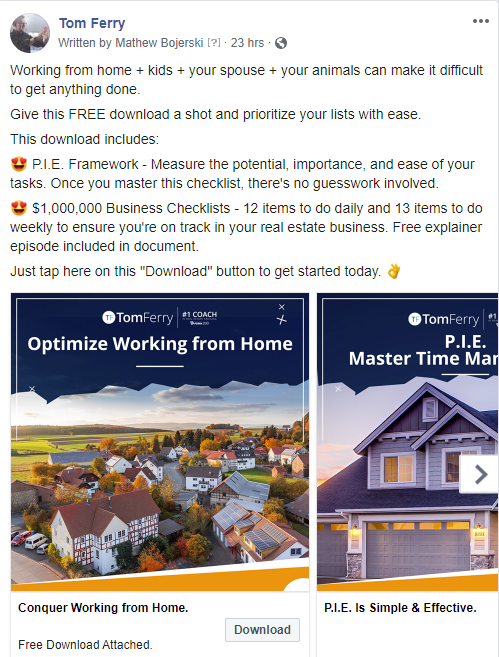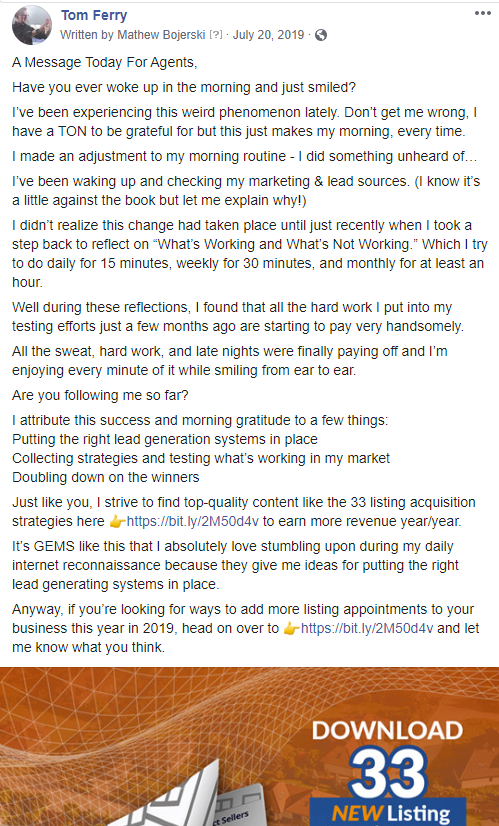Hello everyone ?,
Hope you’re all staying safe and sound through this whole mess.
Today, I wanted to write a quick blog showing the power of copy and creative in Facebook ads and some tips to create similar results for your campaigns.
For this client spotlight, we’ll be talking about Tom Ferry who primarily targets real estate agents.
Relating to Audiences With Copy
I can’t stress this enough.
While writing Facebook copy, you HAVE to relate to your target audience within that first sentence.
Typically, we’ll start with a question.
Something we’ll get an assumptive “YES” to.
But other times, we kick things off with a powerful statement that resonates.
We know everyone is likely going mad with the whole family being home.
“Working from home + kids + your spouse + your animals can make it difficult to get anything done.”

This sentence does quite a few things for messaging:
One – agitates an already existing problem.
Two – acknowledges how our audience is feeling.
Three – insinuates a possible solution.
Four – we’ve included four possible categories for our audience to be bucketed into, working from home, spouse, kids, & animals. Maybe a combination.
I could go on…
An important note, this copy wasn’t created just out of COVID-19, we do this all the time.
Let me show you my process.
Asking the Right Questions
My mentor Robert and I had a conversation over sushi that went along the lines of something like this.
He said to me “Mat, do you know why I take time out of my day to meet with you?”
Jokingly, I said back “Well, it’s obviously because I pay for lunch.”
Robert laughed and shouted back “No! It’s because you’re always asking questions and although I’m giving you answers, I’m actually learning myself.”
We sat in quiet for a moment while I had a chance to ingest what he just said.
Robert was never uncomfortable sitting in silence as he understood the importance of reflection.
(I deemed this best and practiced this often with Robert, as everything that came out of that mans mouth was layered with gold).
After a few minutes, I chimed back in…
“Robert, how do I ask better questions?”
He smiled and said “you start with who.”
“Who”
Knowing who you’re asking a question to is critical.
If you’re writing Facebook copy, you’re more than likely, not your client’s target customer.
And that’s okay, we don’t need to be, when you ask the right questions.
Before you begin writing copy, first identify WHO exactly your ad will be serving to.
Imagine this person in all facets. What do they look like? What are they wearing? What are they doing in their career? What do they have in their life?
The better description you have of this person, generally, the lower and lower your CPL’s will fall.
Why?
I can sell my best friend on anything and vice versa. Can you? ?
Next up is “where.”
“Where”
Know where you’re at.
One of the most simple yet powerful phrases I’ve heard in my life.
Knowing where you’re at gives you the advantage that your competitors would never see coming.
It’s the Mount Everest of planet Earth.
It’s the Venus of our solar system. (sorry Pluto)
It’s the clarity on any situation you could imagine.
This also applies to copy writing.
Where is your target customer in their life?
Observe thoughts about their career, personal life (kids, girlfriend/boyfriend, husband/wife, grand kids, etc.)
Break down their visual & physical environment, what does that look like?
The better idea you have as to what your potential customer is experiencing with their visual senses, the better you’re going to relate to them through copy.
For example, I know, that most SEO’s use at least two monitors and not often three.
Why?
Because one is too slow and three is too many, it pulls away from our focus.
Tell me I’m wrong. ?
JK though, I’m wrong all the time, that’s when we learn.
“When”
One of my personal favorites.
Find a specific moment your potential customer is likely experiencing often.
Could be something out of a daily routine.
Could be a significant moment in their life.
Find a slice of moments, stitch them together, and thoroughly observe how they might have felt.
For example, I once wrote a long-form copy variation for an ad speaking about waking up in the morning, checking my funnels, and smiling while sipping my coffee.
The engagement was off the charts.
Let me see if I can find it.

I think at one point in life, everyone has woken up and smiled, at least once.
This is a significant moment to capture within copy.
The engagement was off the charts.
The post had over 90 comments and 180 shares with 90% of the comments being overwhelmingly positive.
Another way “when” applies to copy is understanding when someone is in their lives.
I know, sentence fragment, ugh.
But hear me out…
Everyone is only who they are at this exact present moment in time.
Sure, some of us are more groomed than others.
And some of us adapt rather quickly while others stay the same and that’s okay.
But in media buying, writing copy to buckets of “when” your target audience is in their life timeline, is going to rake in lower CPL’s and higher CVR.
Knowing “when” your target audience is will allow you to deep-dive into research in forums, Q&A sites, social media, and more with the right search queries.
It’s a rabbit-hole, sure.
I suggest dedicating a specific block of time for this. (and anything you do.)
Remember, time expands to the time allotted. – Tom Ferry.
Bonus Tip
I’d like to continue down this conversation as I find it completely and overwhelmingly fascinating but I have other tasks to attend to.
I’ll leave you with one last item.
If you’re unsure.
Do your research. Write up a list of questions. Find verified buyers of your product/service and/or a competitor and interview them.
That’s it.
Success is supportive of whomever has the most data, research, knowledge, and information on any given topic.
So that’s it, if you like this stuff, leave a comment below and I’ll write more.
Cheers,
M
